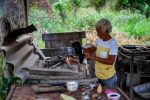
The overall number of members of Colombia’s narco-paramilitary groups known as the BACRIM has fallen by over 20 percent since 2012; however the ranks of the most powerful of these, the Urabeños, continue to swell.
According to the Colombian security forces specialist BACRIM (a name taken from the Spanish abbreviation for “criminal bands”) intelligence unit, the total number of BACRIM members dropped from 4,810 in February 2012 to 3,700 by the end of 2013, reported El Tiempo.
However, the Urabeños have recruited a further 642 members, taking their total numbers to 2,612 — representing 70 percent of all Colombia’s BACRIM. Over 1,500 of these are concentrated in urban areas in 11 departments, according to the report.
SEE ALSO: Coverage of the Urabeños
The Rastrojos, which until the surrender and capture of their leadership in 2012 were considered the largest and most powerful of the BACRIM, have continued their decline, dropping from 2,085 members to 810 over the time period examined.
The report also highlights how the remnants of the Popular Revolutionary Anti-Terrorist Army of Colombia (ERPAC), which broke into two competing factors, the Meta Block and the Heroes of Vichada, also continue to recruit. Over the time period, the Vichada faction increased from 143 members to 200.
InSight Crime Analysis
The new figures reinforce how the Urabeños are not only Colombia’s dominant criminal group but also could soon be considered the only group with the reach and power to be accurately be classified as a BACRIM.
However, the increase in their numbers may not just be the result of a recruitment drive but instead indicative of the Urabeños policy of bringing smaller criminal organizations into their franchise. For example, the Machos were once counted in the BACRIM figures as an independent organization. Yet since striking a deal with the Urabeños in 2011, in which they exchanged control of drug routes for funding, supplies and support in their conflict with the Rastrojos, they have become part of the Urabeños network, even though they are not directly commanded by the Urabeños leadership.
Despite the Urabeños dominance over other BACRIM, the group still remains some way from achieving a monopoly on Colombian organized crime. While there are no other organizations with national reach remaining, they are still fighting bitter and violent local struggles in regions such as Valle del Cauca, where they are in conflict with the remnants of the Rastrojos, Magdalena, where they are fighting the Oficina del Caribe, and the Eastern Plains, where they are believed to have sided with the Heroes of Vichada against the Meta Block.
- Colombia
- Bacrim
- Urabeños











